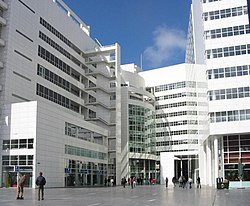Richard Meier
Richard Meier (Newark, October 12, 1934) is an American architect and abstract artist, recipient of the Pritzker Prize and the Gold Medal of the American Institute of Architects, among others. His works have focused mainly on museums, large mansions, temples and offices, in which the light in their spaces and the use of white color stand out, where the spaces harmonize with the surrounding nature.
Biography
He was born in Newark, New Jersey, into a Jewish family. He studied architecture at Cornell University, where he graduated in 1957. Upon finishing his studies he traveled through Europe where he had the opportunity to meet Le Corbusier who would greatly influence his architecture. Upon his return to the United States, he worked in various architectural firms, including Skidmore, Owings and Merrill, and Marcel Breuer, until in 1963 he opened his own practice.
Style
From the beginning, Meier has followed a determined and permanent line in its projects. She has set aside passing trends and fads, and has remained true to his ideas. Although his most recent buildings show a refinement compared to the initial ones, they continue to have the same unmistakable style, in which Meier always attaches the same importance to clarity of lines, harmony, space and light. The organization of his buildings is based on geometric patterns that obey the conditions of his environment, and help him order the interior and exterior spaces. The vast majority of Meier's buildings are white, the color that he considers the purest since it brings together all the others and changes its hue during the day.
According to Meier, Le Corbusier has exerted a great influence on him, as has Frank Lloyd Wright; not to mention other architects have been a reference for his work. However, he considers that architecture is a discipline that is in a continuous flux, which is why the architects who set styles and influence others change over the years.
Awards
Meier has been distinguished among others with the following awards:
- In 1984 he was awarded the Pritzker Prize, the most important international recognition in architecture
- In 1989, Gold Medal by the Royal Institute of British Architects,
- In 1997 he received the highest American award of his profession, the gold medal of the American Institute of Architects.
He has also been awarded the Premium Imperiale from the Japan Art Association. Between 1970 and 1976 he was recognized as one of the members of the group of architects known as The New York Five, along with Michael Graves, Peter Eisenman, John Hejduk and Charles Gwathmey.
Shortly after receiving the Pritzker Prize, Meier was commissioned to design the Getty Center in Los Angeles, a large complex of buildings that for any architect was one of the most interesting and important projects that could be awarded.
Another major project is the Jubilee Church in Rome. On the occasion of the Jubilee year of 2000, the Holy See organized an international competition for the realization of a new parish in Tor Tre Teste, on the outskirts of Rome, of which Richard Meier was the winner.
Representative works
- Westbeth Artists Community, New York City, 1970
- CondominiO del Olivetti Training Center in Tarrytown, New York, 1971
- Meier House, Essex Fells, New Jersey, 1965
- Smith House, Darien, Connecticut, 1965-1967
- Casa Saltzman [New York], 1969
- Douglas House, Harbor Springs, Michigan, 1973
- Bronx Mentally Decreased Centre, New York, 1976
- Shamberg House (Chappaqua, New York), 1972-1974
- Atheneum Building (tourist information center, New Harmony, Indiana, 1979
- Hartford Seminar, Hartford, Connecticut, 1981
- High Museum of Art, Atlanta, Georgia, 1983
- Modern Art Wing Des Moines Art Center, Des Moines, Iowa, 1984
- Museum of Decorative Arts (Fráncfort, Germany), 1985
- Central Canal + headquarters building (Paris), 1990
- Daimler-Benz Research Centre (Ulm, Germany), 1992
- Hypobank International Building (Luxembourg), 1993
- Stadthaus Ulm, Ulm, Germany, 1994
- Museum of Contemporary Art, Barcelona, Spain, 1995
- New Town Hall (The Hague, Netherlands), Netherlands, 1995
- Edinburgh Park Masterplan, 1995
- Rachofsky House, Dallas, Texas, 1996
- Neugebauer House, Naples, Florida, 1998
- The Paley Center for Media, formerly The Museum of Television " Radio, Beverly Hills, California, 1996
- Getty Center, Los Angeles, California, 1997
- Camden Medical Centre, Singapore, 1998
- White Plaza, Basel, Switzerland, 1998
- 173/176 Perry Street, Manhattan, 1999–2002
- Sandra Day O'Connor United States Courthouse, Phoenix, Arizona, 2000
- United States Palace of Justice Alfonse M. D'Amato, Central Islip, New York, 2000
- Peek & Cloppenburg flagship store, Düsseldorf, Germany, 2001
- Centre for Possibility thinking, Garden Grove, California, 2003
- Jubilee Church, Rome, Italy 2003
- Museum Frieder Burda, Baden Baden, Germany, 2004
- Ara Pacis Museum (Rome), Italy, 2006
- City Tower, Prague, Czech Republic, 2004–2007
- Arp Museum, Remagen-Rolandseck, Germany 2008
- San Jose City Hall, San José, California, 2004–2007
- University of Scranton, Connolly Hall, 2007
- Weill Hall, Ithaca, New York, 2008
- Meier Tower, Tel Aviv, Israel (2008–present)
- On Prospect Park, Brooklyn, NY, 2003–2008
- International Coffee Plaza, Hamburg, Germany, 2010
- Bodrum Houses, Bodrum, Turkey, 2010–present
- Vinci Partners Corporate Headquarters, Rio de Janeiro, Brazil, 2012
Accusations of sexual harassment
On March 13, 2018, The New York Times detailed allegations from five women that Meier had sexually harassed and/or assaulted. Meier responded by saying that he would be taking a six-month leave of absence from his company.





